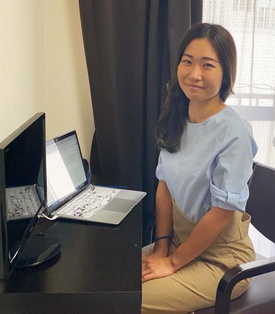A vast area and a wide range of readers

The Japanese media we have introduced so far have focused on one or more specific areas: Los Angeles, Seattle, New York, and San Francisco, but the free Japanese magazine we will introduce this time, USFrontLine, is distributed to many areas across the United States where there are Japanese communities.
"The three areas with the highest distribution are Los Angeles in California, the San Francisco area, and New York, but we also distribute to areas across the United States with a large number of Japanese companies, such as Atlanta, Georgia; Chicago, Illinois; Ohio; and even Texas, where Toyota relocated its headquarters from California a few years ago. Our readers are basically Japanese expatriates, but we go beyond that and cover a wide range of topics including business information, education, law, health, travel, and entertainment, so it is read by a wide range of Japanese readers living in America," explains Saito Haruna, editor-in-chief of the magazine.
What makes this magazine unique is not only that it covers the entire United States, but also that it is a combination of two Chinese-language magazines, with another Chinese-language magazine starting on the back cover. The Chinese-language magazine, "J-goods," introduces Japanese products and culture to Chinese people living in the United States. By combining with "J-goods" a few years ago, "US FrontLine" is now distributed to Chinese markets across the United States.
As I recall, US FrontLine was headquartered in New York. At the time, it was a larger-format magazine than the current letter size, and was published as a weekly magazine for a long time. Later, the magazine became part of an IT company, moved its headquarters to Los Angeles, and is now published bimonthly, with each issue being 32 to 40 pages long. Because the magazine itself is published once every two months and has limited space, information that does not fit in the magazine, as well as the latest news and announcements, are posted on a frequently updated website.
The magazine's content consists of several pages of feature articles with a specific theme in each issue, as well as essays and serialized columns on life in America, such as education and English conversation. What kinds of articles are popular with readers? "It's difficult to tell from the magazine which articles are popular, but judging from the number of views of online articles, there seems to be a lot of interest in education-related articles. Additionally, articles on immigration law and employment rules, which contain information important to Japanese companies, are also read by many people."
What are the advantages of paper media?
Saito says that because it is a national publication that does not focus on a specific region, the key is to cover the theme of "what is happening in America right now." "Feature plans are decided by three or four people involved in the magazine, including sales. We always try to deliver original and new information to our readers. We take a good look at world trends and topics that are attracting a lot of attention, and even if the information is already well known, we try to approach it from a different angle so that readers will find it interesting and will not get bored."
In addition, the parent company is an IT company that is also involved in recruitment and accounting outsourcing in addition to IT and media, so "in the future we would like to apply the specialized knowledge of staff from our other business divisions to the pages of the magazine."
As mentioned above, US FrontLine not only has a magazine, but also a web version with more up-to-date information, but when I asked Saito if there were plans to move everything to the web, he replied: "The magazine is picked up by readers who think, 'I want to see this (a particular article)'. Readers who read every issue are in the habit of picking up the magazine, so we can deliver that information to them reliably. On the other hand, in the online world, people search for the information they want and end up on unspecified websites, so they don't necessarily come to the US FrontLine site. Limiting ourselves to the web would also limit our readership. As the times are changing, one option is to move completely to the web, but in order to do so, I think we need to carefully examine how we can overcome the disadvantages."
Saito himself, like the magazine's readers, is one of the "Japanese people living in America." "I wanted to work in America, so I applied for my current job and joined the company in June 2017. I was originally a magazine editor at a Japanese publishing company. In Japan, we made magazines with about eight editorial staff, but now I'm basically the only one doing the editing for both the magazine and the web version, so I have a lot more responsibility than before."
As an editor, she keeps her antennae up in all directions. "I often have the opportunity to meet with Japanese companies who are my advertising clients, so I try to ask them about what interests them and what is happening around them. I also keep up with American news, as well as Japanese news online, and try not to fall behind on the latest trends."
US FrontLine is the only free Japanese-language information magazine covering the entire United States. It has undergone several transformations, including its format and publication frequency, and we would like to keep an eye on its future, including its coexistence with the web version and its separation.
US FrontLine official website: https://usfl.com
© 2021 Keiko Fukuda







